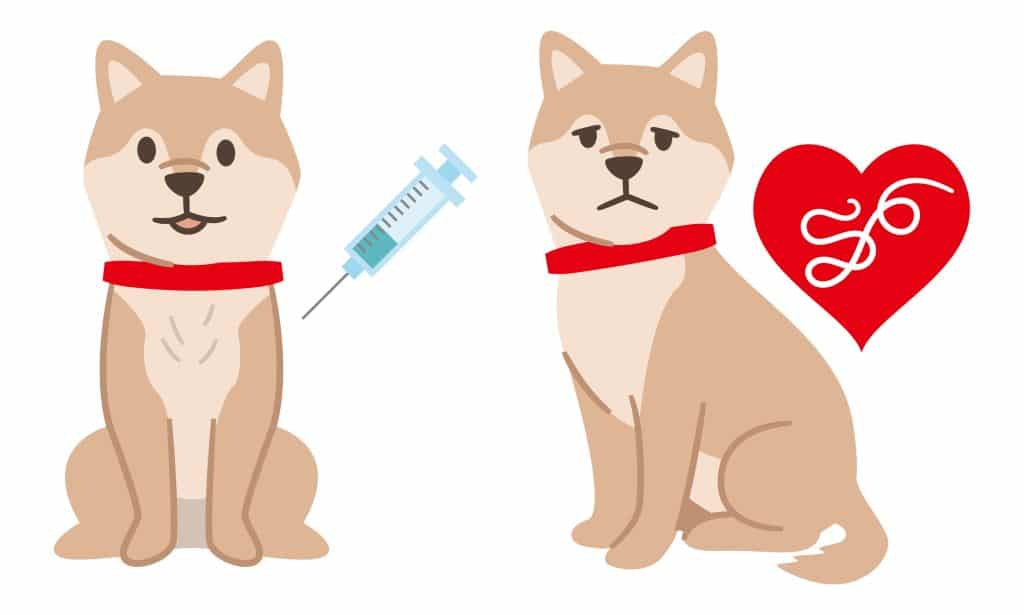Depending on where you live, your vet may inform you about prevention from a parasite called dirofilaria or heartworms. In this article, we’ll explain what dirofilaria is, how it happens, how you can protect your dog, and so on.
Heartworms or dirofilaria is a parasitic disease that is caused by a parasite called dirofilaria immitis. In many cases, when the heart is invaded, it could be potentially deadly to your dog. Regular prevention is the best way to protect your pooch from this vicious disease.
Table of Contents
Let’s Learn More About Heartworms And How Your Dog Can Get Them
Adult dirofilaria worms usually live in the heart and blood vessels and rarely travel to other parts of the body. Usually, female heartworms are larger than males. During their life, they can produce millions of offspring. They are microfilaria, and they tend to live in small vessels.
However, the reproduction of this parasite is quite complex. Transmission of dirofilaria is not that simple, and it is not through direct contact. Sand flies and mosquitoes transmit it.
When a mosquito sucks blood from an infected dog, it gets the parasite. The dirofilaria needs the mosquito as an intermittent host before it can infect a new healthy dog. Once the mosquito gets onto a healthy dog and sucks its blood, the parasite is transmitted to the local tissue and enters the small vessels where it begins its development and growth into adulthood. It also starts procreating, at which point the cycle continues.
What Do Heartworms Do To Your Dog?
This disease shows signs once things get complicated. While the dog has microfilaria traveling around its vessels, the dog usually does not show any signs of disease. The first clinical signs may show up around the second year. The reason for this is that the microfilaria takes at least 5 to 7 months to develop into adults. In many cases, once the clinical signs show up, the disease has greatly advanced.
Since adult worms live in the heart, they could damage it and cause obstruction of the great vessels. This consequently damages other organs too, as they do not get enough oxygen due to a lack of proper blood movement. In these cases, dogs show signs such as loss of breath, exercise intolerance, and a dry and soft cough. In the later stages of the disease, the dog can show signs of heart failure and ascites, which is fluid accumulation in the abdomen.
Microfilaria also travels around the body and may cause obstruction in the smaller vessels. Usually, this happens in the liver and the lungs. In cases like this, the dog may show signs like coughing or liver failure. In rare cases, their kidneys could be affected too, which causes the accumulation of toxins.
How Do Vets Diagnose Heartworms?
The most common way for a dog to be tested for dirofilaria is by drawing blood and doing a snap test. The results usually come within minutes. These tests are based on antigens that the adult dirofilaria releases into the bloodstream. When detected, that could mean the dog was bitten at least five months prior to the detection of the parasite.
Another way to detect microfilaria is when they’re in the blood. The earliest time for this test to detect the presence of microfilaria is 6 months. The presence of these tiny heartworms confirms the presence of adults in the dog.
A Vet Diagnosed Your Dog With Heartworms. Now What?

The course of treatment usually depends on the general state of the dog. For example, has it shown clinical signs? Vets usually recommend blood work and biochemistry and if needed they will recommend x-rays and ultrasounds for the heart and lungs. There are different ways of treating dirofilaria and which protocol your vet chooses depends on the stage of the disease.
Usually, the treatment is against the adult dirofilaria or against the microfilaria. The important part for both treatments is that you strictly need to follow the instructions your vet gives you. As with any treatment, they too present certain risks.
Can I Prevent Heartworms?
Yes! And the answer to how is simple – by using tablets of collars that protect against sand flies and mosquitoes. This prevents your dog from ever coming into contact with an infected insect. If you want to protect your furry friend, schedule a consultation with your vet to talk about possibilities.
Conclusion: What Are Heartworms?
Dirofilaria is a scary parasitic disease, but owners can prevent it. As owners, we always try to do the best for our pooches. As a vet, I always recommend to owners that they do a yearly check-up with a snap test before the mosquito season starts. If negative, we can discuss how best to protect the dog. I have diagnosed so many dogs in the early stages of the disease this way, and with the dedication of their owners, we have successfully treated them.
So, are you scheduling a snap test with a vet soon? Have you had any experiences with dogs and heartworms? Let us know in the comments below!
